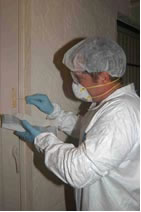Archival Notice
This is an archive page that is no longer being updated. It may contain outdated information and links may no longer function as originally intended.
Home | Glossary | Resources | Help | Contact Us | Course Map
Blood can contain pathogens such as the hepatitis B virus, hepatitis C virus and the human immunodeficiency virus (or HIV). It is essential to regard all biological evidence as potentially infectious and to follow universal safety precautions.
Those precautions include the following:
- Wear Personal Protective Equipment (PPE), such as gloves and face masks.
- Avoid eating, applying cosmetics or any hand to face contact (especially mouth and eye).
- Use implements and wear puncture resistant gloves to handle objects that may be dangerous, such as broken glass. Ensure safe packaging is used.
- Identify biohazardous evidence material and packaging in containers with appropriate labeling.
Additional Online Courses
- What Every First Responding Officer Should Know About DNA Evidence
- Collecting DNA Evidence at Property Crime Scenes
- DNA – A Prosecutor’s Practice Notebook
- Crime Scene and DNA Basics
- Laboratory Safety Programs
- DNA Amplification
- Population Genetics and Statistics
- Non-STR DNA Markers: SNPs, Y-STRs, LCN and mtDNA
- Firearms Examiner Training
- Forensic DNA Education for Law Enforcement Decisionmakers
- What Every Investigator and Evidence Technician Should Know About DNA Evidence
- Principles of Forensic DNA for Officers of the Court
- Law 101: Legal Guide for the Forensic Expert
- Laboratory Orientation and Testing of Body Fluids and Tissues
- DNA Extraction and Quantitation
- STR Data Analysis and Interpretation
- Communication Skills, Report Writing, and Courtroom Testimony
- Español for Law Enforcement
- Amplified DNA Product Separation for Forensic Analysts


